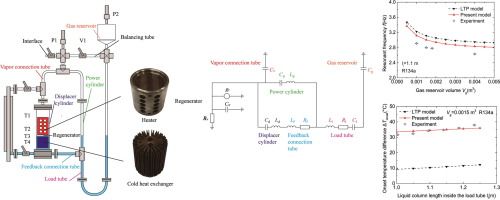Applied Energy ( IF 10.1 ) Pub Date : 2020-01-20 , DOI: 10.1016/j.apenergy.2020.114539 Jingqi Tan , Jianjian Wei , Tao Jin

|
An electrical-analogy network model including a regenerator model based on wet thermoacoustic principle is proposed to predict the resonant frequency and the onset temperature difference of a modified two-phase thermofluidic oscillator, which is similar to a non-inertive-feedback thermofluidic engine reported in the literature. Besides, a screen-stacked regenerator is introduced to reduce the irreversible loss induced by heat transfer and a gas reservoir is inserted to tune the acoustic field. An electrical capacitance that accounts for the compressibility caused by thermal-relaxation effect and an electrical resistance that accounts for the heat loss due to viscous dissipation are included in the regenerator model, with all other components modeled based on lumped principle. The electrical-analogy network model can well predict the onset temperature difference in both trend and magnitude, with which the deviations from experimental results are only 0.8–5.8% for the present model, while they are 68.5–72.0% for the previous linear temperature profile heat exchanger model. In addition, the calculated and experimental resonant frequencies are also in reasonable agreement, since the present model overestimates the measured resonant frequencies by 1.5–12.5%, while the previous model overestimates by 5.2–16.5%. The effects of the liquid column length inside the load tube, the gas reservoir volume and the working fluid on the resonant frequency and the onset temperature difference are investigated. The results from this work can help to better understand and then optimize a two-phase thermofluidic oscillator.
中文翻译:

带有蓄热器的低级热回收改进型两相热流体振荡器的电学网络模型
提出了一种基于湿热声原理的包括蓄热器模型在内的电模拟网络模型,以预测改进的两相热流体振荡器的谐振频率和起始温差。文献。除此之外,还引入了一个筛网式蓄热器,以减少由热传递引起的不可逆损失,并插入一个储气罐以调节声场。蓄热器模型中包括一个考虑到热松弛效应引起的可压缩性的电容和一个考虑到由于粘性耗散造成的热损失的电阻,而所有其他组件均基于集总原理进行建模。电气模拟网络模型可以很好地预测趋势和幅度上的开始温度差,对于当前模型,与实验结果的偏差仅为0.8–5.8%,而对于先前的线性温度曲线,则为68.5–72.0%换热器模型。此外,由于当前模型将测得的共振频率高估了1.5–12.5%,而先前的模型高估了5.2-16.5%,因此,计算出的共振频率和实验共振频率也有合理的一致性。研究了负载管内液柱长度,储气罐体积和工作流体对共振频率和起始温度差的影响。这项工作的结果可以帮助更好地理解并优化两相热流体振荡器。











































 京公网安备 11010802027423号
京公网安备 11010802027423号